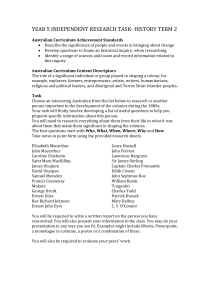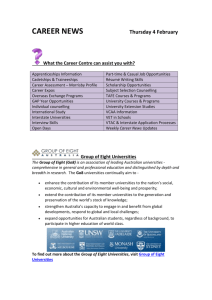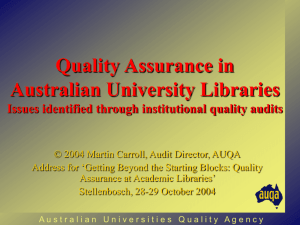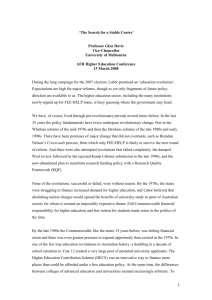An Innovation agenda for 2010
advertisement
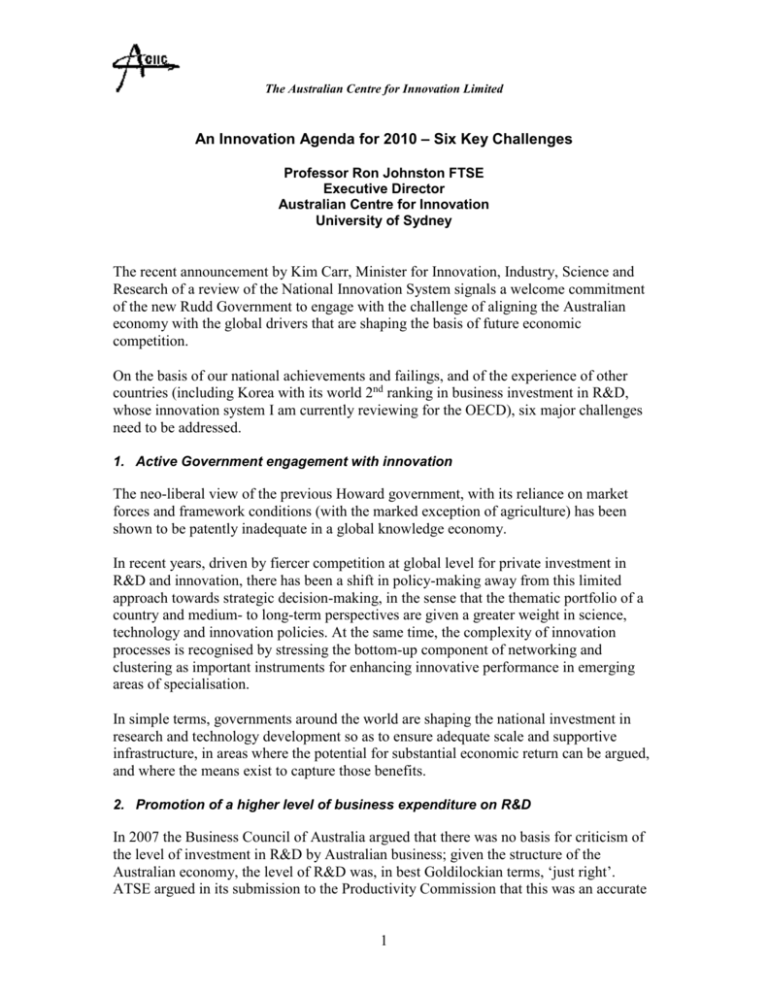
The Australian Centre for Innovation Limited An Innovation Agenda for 2010 – Six Key Challenges Professor Ron Johnston FTSE Executive Director Australian Centre for Innovation University of Sydney The recent announcement by Kim Carr, Minister for Innovation, Industry, Science and Research of a review of the National Innovation System signals a welcome commitment of the new Rudd Government to engage with the challenge of aligning the Australian economy with the global drivers that are shaping the basis of future economic competition. On the basis of our national achievements and failings, and of the experience of other countries (including Korea with its world 2nd ranking in business investment in R&D, whose innovation system I am currently reviewing for the OECD), six major challenges need to be addressed. 1. Active Government engagement with innovation The neo-liberal view of the previous Howard government, with its reliance on market forces and framework conditions (with the marked exception of agriculture) has been shown to be patently inadequate in a global knowledge economy. In recent years, driven by fiercer competition at global level for private investment in R&D and innovation, there has been a shift in policy-making away from this limited approach towards strategic decision-making, in the sense that the thematic portfolio of a country and medium- to long-term perspectives are given a greater weight in science, technology and innovation policies. At the same time, the complexity of innovation processes is recognised by stressing the bottom-up component of networking and clustering as important instruments for enhancing innovative performance in emerging areas of specialisation. In simple terms, governments around the world are shaping the national investment in research and technology development so as to ensure adequate scale and supportive infrastructure, in areas where the potential for substantial economic return can be argued, and where the means exist to capture those benefits. 2. Promotion of a higher level of business expenditure on R&D In 2007 the Business Council of Australia argued that there was no basis for criticism of the level of investment in R&D by Australian business; given the structure of the Australian economy, the level of R&D was, in best Goldilockian terms, ‘just right’. ATSE argued in its submission to the Productivity Commission that this was an accurate 1 The Australian Centre for Innovation Limited answer to the wrong question. What was important was whether the structure of Australian industry, and hence its R&D investment, was appropriate to provide the basis of a competitive economy in the future, when the mining boom eventually subsides. While the long-held view of Treasury that what counts is what you do with technology developed wherever, rather than relying on nationally generated technology, still holds some water, the speed and intensity of investment in the new nano-, bio-, cogno- and IT technologies is such that any nation without the capacity to understand and engage with the new technologies is likely to be left as a slow, and dependent, follower. The remedies will include some adjustment to the tax incentives, further strengthening of the venture capital industry and links between universities, government labs and industry, and greater efforts to engage with the great Australian diaspora. 3. Enhanced funding for Universities The previous Government, almost alone among OECD nations, allowed the funding for universities to substantially decline, but in addition matched its reduced budgetary responsibility with greatly increased intervention. The result has been a very serious weakening of the capabilities of the universities in Australia to play their crucial role as generators, translators and transmitters of knowledge. Two things are required – progressive restoration of an adequate funding base, and the establishment of an explicit partnership between the government and universities to collectively pursue the strengthening of the knowledge economy in Australia. 4. Rejection of the ‘commercialisation at all costs’ model of knowledge exploitation Over the past five years, the drive to extract value from the public investment in R&D became diverted into a narrow cul-de-sac that emphasised only the commercialisation route via licenses and start-up firms. While commercialisation remains an important objective, which can be further strengthened, it must be recognised that much greater value is generated vis the diffusion of knowledge to existing organisations in the private and public sector. In some quarters there has been a call for a ‘back to basic research’ movement. This has some justification, but ignores the crucial point that in a knowledge economy, traditional distinctions between basic and applied make little sense, or only within the context of one player’s perspective. What is needed in an effective innovation system is widespread recognition that there is potential in all knowledge to be used ‘to act on the world’. The challenge is to facilitate the flow of the knowledge to its potential point of application. In the context of the announced CRC review, let me emphasise that as a member of the previous CRC review team, there was no recommendation that the CRC scheme should fund only commercial research. Rather we emphasised that there was a need to 2 The Australian Centre for Innovation Limited distinguish between the objectives of commercial return and public good, and evaluate them against different criteria. It was the then-Government that chose the narrow emphasis which has been demonstrated to be counter-productive. 5. Recognition of the crucial role of non-technological innovation Too often in Australia, consideration of innovation becomes transformed into funding for scientific research. While the latter is of course important, and needs to be maintained, the view of industry and many others that much of innovation is based on reworking and use of existing information in a better form, embodied in a new business process, or service or marketing and logistics strategy. For example, the degree of innovation in the financial services industry is huge (if not always to the benefit of all customers), and while it is based on research, almost none of it is ‘scientific’. Knowledge-intensive business services using IT platforms to deliver a vast array of new services generally compose the fastest growing sectors of a knowledge economy. In this manner, and through the creative industries, there is an enormous role for appropriately directed research in the social sciences and the humanities. A very powerful model of how to marshal this capability to address national issues is provided by the UK Social and Economic Research Council. 6. Enhancing our strategic intelligence The complexity, uncertainty and speed of change associated with contemporary issues and capabilities make it increasingly difficult for governments, indeed all decisionmakers, to make effective and informed decisions. Two recent responses, complementary to each other, appear to offer a useful approach. The first is to invest, at the national level, in establishing a significant capability in strategic intelligence – a capability that addresses and explores possible futures, through a combination of horizon scanning, anticipatory intelligence, technology roadmaps and foresight. A number of European and Asian countries have started on developing this capability. The second is to recognise the importance of what has been called distributed policymaking and intelligence. In this view policy making is not just about government, but also about the joint impact of public and private decision-making and the networked interactions that precede formal decision-making. In other words, the role of government is shifting from being a central steering entity to that of a moderator of collective decision-making processes. Attention to these six challenges would appear to offer a useful place for the Innovation System Review to begin. 3





